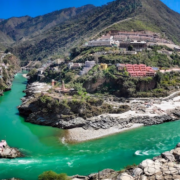
Exploring Pangot: A Tranquil Bird Watcher’s Paradise in Uttarakhand
Nestled in the picturesque Kumaon region of Uttarakhand, Pangot is a charming hamlet that has garnered a reputation as a haven for nature lovers and bird enthusiasts. Situated just 15 kilometers from the bustling hill station of Nainital, Pangot offers a serene escape from the cacophony of urban life. With its lush green forests, diverse wildlife, and mesmerizing landscapes, this quaint village promises an unforgettable experience for those who seek solace in nature’s embrace.
The Avian Wonderland
Pangot is internationally acclaimed for its rich avifauna. It is home to over 580 species of birds, making it a dream destination for ornithologists and bird watchers alike. The village lies on the migratory route of several bird species, attracting a plethora of feathered visitors throughout the year.
Some of the notable birds spotted in Pangot include the Himalayan griffon, lammergeier, rufous-bellied woodpecker, and a variety of pheasants like the kalij pheasant and cheer pheasant. Vibrant songbirds such as the Himalayan bulbul, scarlet minivet, and blue-winged minla add a splash of color to the verdant landscape. Winter months see the arrival of migratory species, while summer months are ideal for observing resident birds in their natural habitat.
Birdwatching trails around Pangot, like the Kilbury Forest trail and Cheena Peak, are popular among visitors. These trails wind through dense oak, pine, and rhododendron forests, offering not just avian delights but also breathtaking views of the surrounding hills.
Flora and Fauna Beyond Birds
While birds are the stars of Pangot, the region’s biodiversity extends beyond its feathered residents. The forests around Pangot are part of the Naina Devi Himalayan Bird Conservation Reserve, home to leopards, barking deer, Himalayan martens, and mountain goats. The flora is equally captivating, with dense oak and pine forests interspersed with rhododendron blooms that turn the landscape into a vibrant canvas during spring.
Butterflies fluttering amidst wildflowers add to the village’s natural charm. The occasional sighting of Himalayan black bears or yellow-throated martens further underscores Pangot’s status as a biodiversity hotspot.
Activities to Indulge In
Birdwatching and Photography
The primary draw of Pangot is its birdwatching opportunities. Carry a pair of binoculars and a camera to capture the village’s stunning birdlife. The early morning hours are particularly rewarding for birding as the forest comes alive with melodious chirping.
Trekking and Nature Walks
Several trekking trails originate from Pangot, leading to scenic spots like Naina Peak and the Corbett National Park’s boundaries. These trails offer not only adventure but also panoramic views of the Himalayan range and the surrounding valleys.
Camping and Stargazing
Pangot’s pristine environment and minimal light pollution make it an excellent spot for camping and stargazing. Spend the night under a blanket of stars, listening to the symphony of the forest.
Accommodation and Local Cuisine
Pangot offers a range of accommodations, from cozy homestays to eco-friendly resorts. These lodges are often designed in harmony with the surrounding environment, providing comfortable stays amidst nature.
The local cuisine is simple yet delightful, with flavors that reflect the region’s traditions. Dishes like Aloo Ke Gutke (spiced potatoes), Bhatt Ki Churkani (black bean curry), and Singori (a sweet made of khoya wrapped in maalu leaves) are must-tries. Many lodges also serve meals featuring locally sourced ingredients, giving visitors a taste of authentic Kumaoni flavors.
How to Reach Pangot
Pangot is well-connected by road, rail, and air. The nearest airport is Pantnagar Airport, about 80 kilometers away. Kathgodam, the closest railway station, is 50 kilometers from the village. From both locations, taxis are readily available. For those traveling by road, Pangot is a scenic drive from major cities like Delhi (approximately 300 kilometers) and Nainital (15 kilometers).
Best Time to Visit
Pangot can be visited year-round, but the experience varies with the seasons. Summers (March to June) offer pleasant weather, making it ideal for trekking and birdwatching. The monsoon season (July to September) turns the landscape lush green, though heavy rains can sometimes hinder travel plans. Winters (October to February) bring chilly weather and snow, along with sightings of rare migratory birds, making it a magical time for nature lovers.
Conclusion
Pangot is more than just a destination; it is a retreat for the soul. Whether you are a passionate birdwatcher, a trekking enthusiast, or someone simply seeking peace amidst nature, this idyllic village will leave you spellbound. With its untouched beauty and tranquil ambiance, Pangot stands as a testament to the wonders of the Himalayan wilderness—a place where time slows down, and nature takes center stage.
Recent Posts
Exploring Pangot: A Tranquil Bird Watcher’s Paradise in Uttarakhand
Devprayag: The Sacred Confluence of Rivers and Cultures
Rudraprayag: A Confluence of Spirituality and Natural Beauty
All Categories

Thailand




